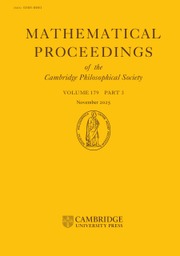Article contents
Finite subtransitive sets
Published online by Cambridge University Press: 11 January 2006
Abstract
Let $\varphi\,{:}\,G \,{\rightarrow}\,{\rm O}(d)$ be an orthogonal representation of a group $G$. A finite subset $X$ of a Euclidean space ${\bf R}^d$ is said to be subtransitive under$(G, \varphi)$ when it is a subset of an orbit under the action of ${\varphi }(G)$; furthermore, we say that $X$ is finitely subtransitive when it is subtransitive under $(G, \varphi)$ for some finite group $G$. If $X$ is subtransitive under a representation $\varphi\,{:}\,G\,{\rightarrow}\, {\rm O}(d)$ then it is clear that $X$ is spherical; that is, contained in a sphere in the representation space ${\bf R}^d$. In connection with Euclidean Ramsey theory, I.B. Leader [6] has posed the converse question:
Is is true that every finite spherical set is finitely subtransitive?
Information
- Type
- Research Article
- Information
- Mathematical Proceedings of the Cambridge Philosophical Society , Volume 140 , Issue 1 , January 2006 , pp. 37 - 46
- Copyright
- 2006 Cambridge Philosophical Society
- 2
- Cited by

